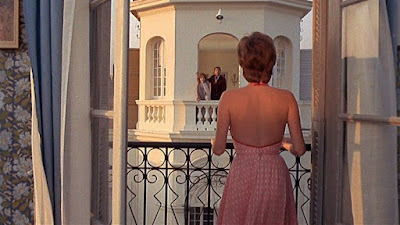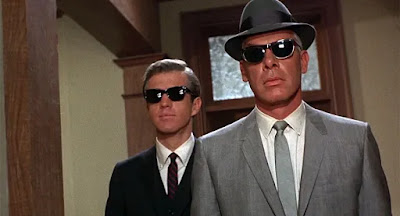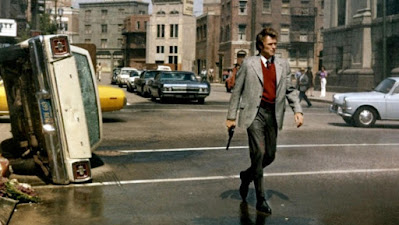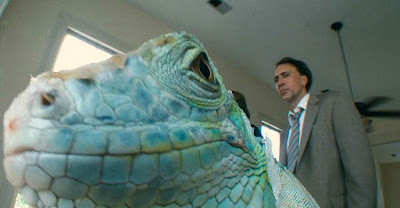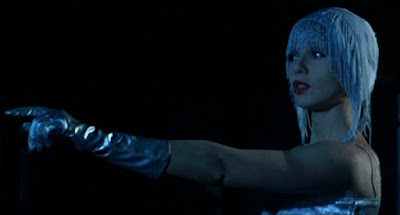 |
| Day For Night (Directed by Francois Truffaut) |
Truffaut revels in the series of mishaps that often create the spark for enhancements to the film: a phrase, a screenplay alteration, a new approach to a scene. Ultimately, this loose, lighthearted narrative serves as the backdrop for an affectionate portrayal of the artists both in front of, and behind the camera, who come together on a shoot via friendships, personal troubles, and love affairs, to form a joyful filmmaking family.
Even as the craft behind the smallest aspects of a feature film is exposed, nothing about it feels like the product of meticulous design. Day for Night appears effortless, as if this was the film Truffaut had been preparing for his entire life.
The “story” revolves around impulsive young actor Alphonse (Jean-Pierre Leaud, evoking a decade of roles in French New Wave films) who wanders around the set asking “Are women magic?” While Truffaut orchestrates his actors around the magic of the film making process. Truffaut appears to be exploring that question by exposing the layers of performance and craft, the offscreen dramas, the plans gone awry, that still leave behind a sense of wonder.
Day For Night has the feel of a mock documentary in many respects. The renowned opening image, an extravagant crane shot floating through a town square, is more than just a typical twist in which the activity seen turns out to be a scene from a movie. Truffaut begins to make us aware of the artifice involved in every cinematic scenario by showing another take with the assistant director's voice bellowing over the top. The film also establishes its documentary style, with a behind-the-scenes film team obtaining quotes from key players, the stars discussing the plot from the perspective of their own characters.
Ferrand does not appear to be making a particularly good or profound picture, despite his earnest devotion to filmmaking. Due to the constraints imposed by the death of a celebrity, he is obliged to eliminate a key moment in the film, an elaborate costume ball. “Meet Pamela”, a melodrama with an international cast and sunny locations has the feel of a commercial obligation, perhaps Truffaut recalling some of his more lightweight endeavours.
Day For Night, appropriately called after a technical term for night scenes shot in daylight with a specific filter, provides a fascinating glimpse into the reality behind the artifice of filmmaking. Soap suds substitute for snow, electric lights for candles, and balconies dangle precariously in the air. Truffaut reveals the tricks of the filmmaker’s trade, much like a conjuror disclosing the secrets behind his magic, but rather than ruining the illusion, it actually adds to the pleasure as the audience get to see and participate in the filmmaking process.
The characters and the actors who play them, as in most Truffaut pictures, are more important than the plot. Ferrand strives to maintain his composure while struggling to keep the production on track and under budget. But he’s dealing with a never-ending stream of catastrophes brought on by his emotionally fragile performers. Ferrand himself remains a mystery, and we never learn what troubles him personally, giving him an air of superiority, as if he is beyond his players’ mundane concerns.
Perhaps the key lies in the fact that Truffaut was a noted film critic and passionate cinephile. His character says at one point, “People like us are only happy in our work.” A statement that certainly applies to Truffaut (one of the more memorable scenes in the film is a dream in which Ferrand recalls himself as a child stealing a publicity still of Citizen Kane from a cinema).
Day for Night is a dense, self-reflexive film, replete with inside jokes and allusions to other films and filmmakers, full of humour and charm, it creates the impression that one has witnessed something much deeper and more realistic than the film’s lightweight tone would suggest.
The following edited excerpt is transcribed from a rare and extensive interview with Truffaut published in the December 1973 edition of Filmmakers Newsletter with journalist Suni Mallow.
SUNI MALLOW: Why did you decide to make a film about filmmaking?
FRANCOIS TRUFFAUT: I had every reason in the world to make a film like that. But I think your question should be, “Why did you, Francois Truffaut, wait thirteen years to make a film on filmmaking?" I cannot answer your first question the way I would for any ordinary film publication because your readers are filmmakers and they should know. To the readers of "Filmmakcrs Newsletter" it is obvious why I made this picture; so the only question is, why did I wait so long to do it.
In my films I have always carefully avoided making any allusions to films and filmmaking, or at best made very indirect allusions to the cinema which could never really bother tne viewing public because they look at the films very naively. But I have thought about making a movie about filmmaking for many years. For instance, each time I make a film I think to myself that I must make a film about filmmaking, and I take notes in a little book I keep in my pocket. I especially took notes while I was shooting Two English Girls and Such a Gorgeous Kid Like Me.
SM: Then why did you finally find it necessary to let the audience in on the mystique of filmmaking?
FT: Because I thought that, although it is a job just like any other, filmmaking is visually much more interesting than most other occupations. In French films they really do not know how to depict somcone's occupation; American directors are far better at that. For instance, when you have a scene with someone working in, for instance, a garage, you see the person working just the way it is in real life. On the other hand, in France they would have a shot of him just coming up from under a car and wiping his hands on a rag, throwing it down, and then the dialogue starts.
You could say that I made Day For Night just as some American directors have made films about hunting or fishing. For instance, a film I like very much is Howard Hawks' HATARI. In that film there are many views of hunting, and although I saw it many times, each time I had the impression that it was exactly like a film about filmmaking. And I am quite convinced that Hawks felt the same way too. You would watch John Wayne leading the expedition into Kenya with his group around him, and in the evening they would stop and have a meal and there would be a little bit of dancing and they would discuss their plan for the next day — which was just like the working schedule for a film. For instance, they would say, "Tomorrow we will hunt giraffe," and then the next day there would be a scene of hunting a giraffe. So although it was indirect, I think that consciously it was very much a film about filmmaking.
SM: When you conceive of a film, do you work initially from a visual concept or from a dialogue/situation one?
FT: That depends very much on the particular scene in the film. When I am writing a script for a film there are some scenes which I can see immediately and which arc very clear in the mind's eye, while other scenes are less clear and just come about as I am shooting them.
It has been my experience in films that when I have had something visual I very strongly worked out beforehand, it's really been a disappointment. Whereas quite often the things that haven't been worked out visually beforehand, and which aren't fixed in my mind's eye, turn out to be some of the more interesting shots.
FT: The only time I ever really worked out anything in great detail like that was in Fahrenheit 451. But I don't work like that for my French films. Obviously the form of the film and the script are there beforehand, but I like to work things out as I go. Or, for instance, I like to spend a Sunday working on the script for the next week's shooting.
SM: Then how do you handle your actors? Do you allow them great freedom for portrayal and improvisation, or do you control their every move, perhaps even use them almost as props?
FT: The treatment varies with each actor. For example, Valentina Cortese in Day For Night did some improvisation, but there was none at all with Jean Pierre Aumont. On the other hand, Jacqucline Bissett was the first actress I'd worked with that I hadn't met before. So in her case I kept her role very vague because I had to find out the kinds of words she could use and what she could sav correctly in French before I could put into her lines words which I felt she could use everyday as part of her vocabulary.
SM: What about the scene where you make a dialogue change for her based on something she has said off the set of the film-within-a-film, "Meet Pamela"? Is that typical of your style as a director? That is, you change actors' dialogue as you get to know them better off the set — as, I believe, Rohmer does with his actors?
FT: Yes, it happens sometimes. Particularly, for example, with Jeanne Moreau.
SM: Why did you use Miss Bisset - that is, put yourself in a position of using an actress you didn't know, with whom you had never worked, and of whose French you were uncertain?
FT: But there was really no problem, Had I fed all the details of what I wanted in the lead actress in Day For Night into a computer, the computer would have told me to take Jacqueline Bisset. For instance, I wanted her to be English and yet famous for having done films in America; she has members of her family who were French; and she has something mysterious about her face. So for all those reasons, I could not have used anyone but Jacqueline Bisset.
In fact, I was so set on having her that I sent her a cable asking her to be in the film more than a year before I began shooting just to ensure that I could have her and she would be free. She brings Hollywood to the film: she brings that aspect of America into the film because she has made films here and people have associations of her with America in films and such actors as Steve McQuccn in Bullitt.
SM: What about the scene in Stolen Kisses where Leaud is in front of the mirror and he repeats names over and over and over. Did you plan that out very carefully for Leaud, or was that his own creation?
FT: That was completely improvised during shooting. You see, I needed the scene because the character has nobody in the film in whom he can confide, yet there was a point in the film where he had to confide in somebody because he didn't know with whom he was in love. So this was his way of showing that he was torn between the two women.
SM: In Day For Night did you use different filmic techniques to distinguish the film-within-the-film from the rest of the film? For instance, old-style Hollywood techniques when you were doing "Meet Pamela" and perhaps modern cinema-verite-type techniques for the rest of the film?
FT: Very much so. For instance, part of the film is done with the camera handheld, whereas for "Meet Pamela" I never show this; that is, I never show a scene which is shot with a hand-held camera.
SM: Was the fixed camera on that crane we see so often?
FT: No, I rarely used the crane.
SM: A 35mm camera is a heavy piece of equipment to put on a shoulder. What system did you use? FT: Well, first of all the cameraman was excellent and you could hardly see it move. And then we used the Panavision system, which I think is very fine.
SM: How much direct involvement do you personally have in the technical aspects of a production?
FT: I don't look at what I am shooting through the camera very much, however I do talk things over with the cameraman and discuss the lighting and the framing. But I would much rather keep my eye on the acting and the actors than deal with the camera. And I never cover myself when I shoot. I take it only from one angle and don't make extra shots from, say, the sides. I believe that every shot has only one angle, one lens.
SM: Do you feel the same way about the editing? That there is only one way a scene can be edited?
FT: There are often things that can be changed, and as you work you discover good ideas from what you see in the cutting room.
SM: How closely do you supervise the cutting of a picture?
FT: I work very closely with the editor and look at it continually with him until the end.
SM: For some people the film is made in the camera, in the shooting; for others it is almost entirely worked out in the editing. In your work, do you emphasize one over the other?
FT: No. I like every stage of the filmmaking process. But while I like to do the script, I detest all the pre-production work because it is full of anxiety. I love the actual shooting, and the cutting and the mixing are fascinating.
SM: In the case of Day For Night you were working with your own script. When you use someone else's material as the basis for a film — say, the novel for Jules and Jim or Two English Girls — how true to the original do you feel you must be?
FT: I am always changing as I go along. But sometimes I like the words or phrases too much and will stick too faithfully to the original. However, I definitely prefer to work on my own material, and I hope that in the future I will not do any more adaptations and will work only from my original screenplays.
SM: What are your favorite shots in Day For Night?
FT: I find particularly entertaining the scene in the film where Alexander (Aumont) and I are going up the stairs to the cutting room and as we are going up the crane is coming up at the same time. Then as we go behind the Moviola the camera zooms in on us and frames us very tightly. This pleased and amused me very much because the way it turns out shows how it was done and how Hollywood would do that sort of thing - with the crane coming up and then zooming dramatically in on this crummy little cutting room at the top of these rickety old stairs.
SM: Are there any scenes which are not in the final version of the film? And if so, why were they cut? For budget reasons? Length? They simply didn't work visually?
FT: Yes. there are one or two scenes that are not there, but it was because I felt they weren't well enough acted.
SM: What is your overall opinion of Day For Night? Does it match up to your expectations?
FT: I think the film is twenty minutes too short because there was a lot to say. I was 90 per cent satisfied with the dialogue and probably 60 per cent satisfied with the visual. In the visual, I had the sun in certain scenes, and I hate bright sunlight in color films and have disliked it for several years now. But I didn't have the means to do the scene over another day. And there are probably some other faults here and there throughout the picture.
SM: Is that usual with your pictures — that only 60 per cent pleases you?
FT: Yes, about that. But in Fahrenheit 451 I think it was maybe better visually.
SM: In the film the ending of "Meet Pamela" is changed because of the death of a member of the cast but also because of financial pressures from the backers. To what degree must you, Francois Truffaut, as a well-known artist and director, bend the content of your films to financial pressures?
FT: Personally I do not often worry myself with this aspect… In the ending of Day For Night what I hoped to show was that the director of a film is not unhappy with accidents. The accident which occurs at the end and changes the shooting is a good thing; it is stimulating. The scene in the projection room where they are discussing Alexander's death in the picture begins on a sad note because of his death in real life, but as it progresses you can see that the director is excited — he realizes he doesn't need the scene that he had originally intended. When he comes up with the idea of shooting Alexander in the back, he is very excited about the idea and says, "Yes, we'll shoot him in the back. It will be even better that way because it's more cruel!" And the script girl, who is used to working with this director and who knows his character and what he likes in his films, says, "Yes, and we could shoot the scene in the snow!" And I think this excitement and pleasure comes over in the film.
So on the one hand there is the anxiety of the director. For example, on weekends I am very afraid and I don’t like the actors to go skiing because they could break their legs. But on the other hand, when something happens which was not planned I simply accept it because the world just keeps going around and the film must keep going forward as if it were something alive. Accidents should be transformed into something good, something favorable and positive for the film, and I hope that I showed this. So it is for this reason that I don't like to make plans on the financial side because it is not in my character. One just has to adapt to all these problems. And I think that is the truest aspect of Day For Night because it shows how I react in the face of these sort of things.
SM: Many directors enjoy that moment when something unaccounted for happens and they have to change the script, but it's different when you have to change it because the distributors or the backers feel that it will be more viable commercially if it is changed.
FT: No, I don't like that either. But it so happens that this has never happened to me.
Transcribed and edited from A Portrait of Francois Truffaut. An Interview With Francois Truffaut by Suni Mallow. Filmmakers Newsletter, December 1973.


